I started to de-wire a grafted California juniper yesterday when I realized the tree was loose in the pot. The culprit was a loose tie-down wire.

Grafted California juniper – 25″
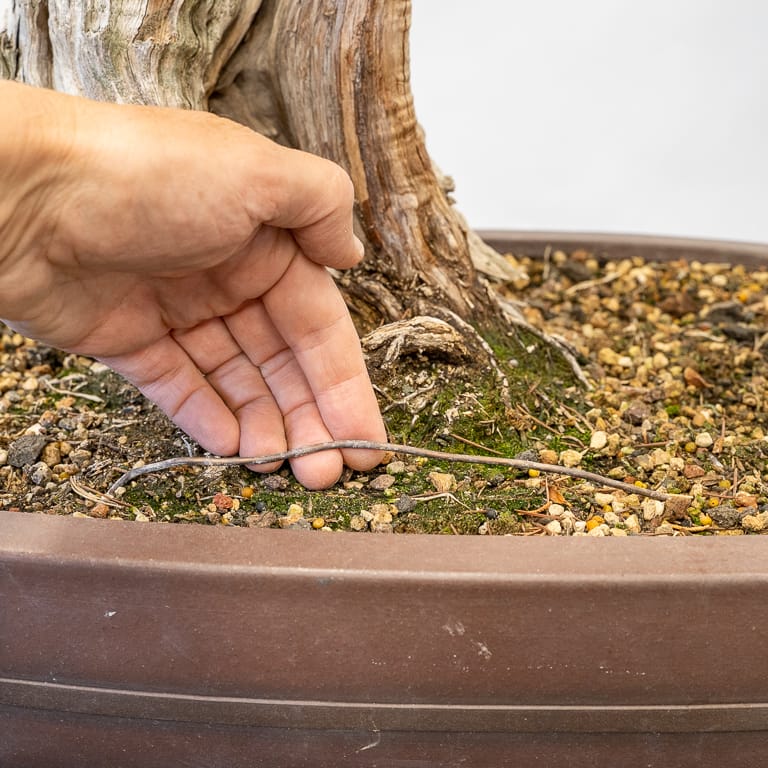
Loose tie-down wire
There are a number of reasons why tie-down wires can become loose over time. If deadwood or wood blocks in the soil rot before the roots fill the pot, this can allow the tree to move.
I prefer to work on trees that are well-secured in the pot so I went about tightening the existing wires. To do this, I cut the loose wire so I could attach an additional wire that would allow me to better secure the tree.
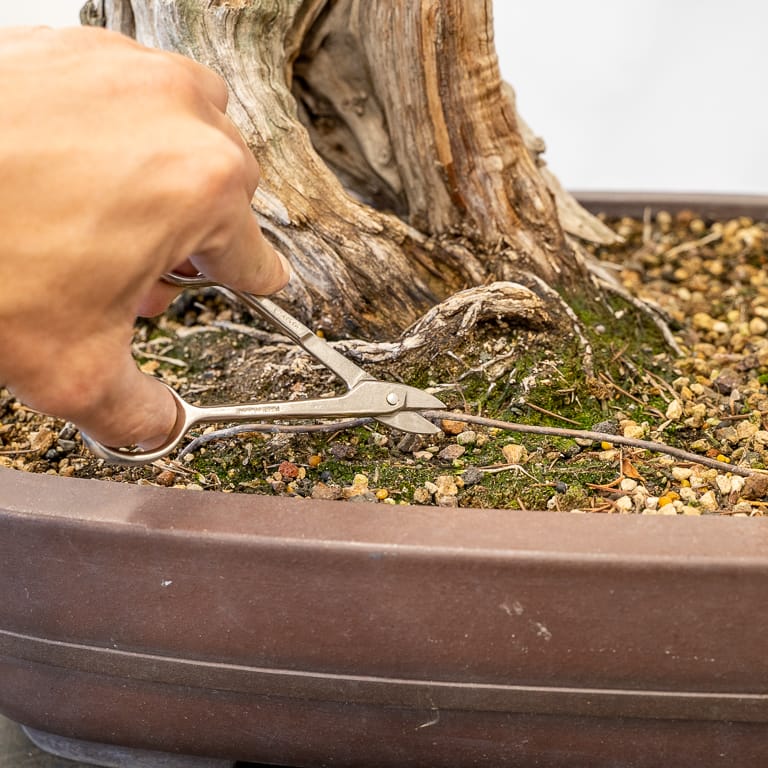
Cutting the tie-down wire
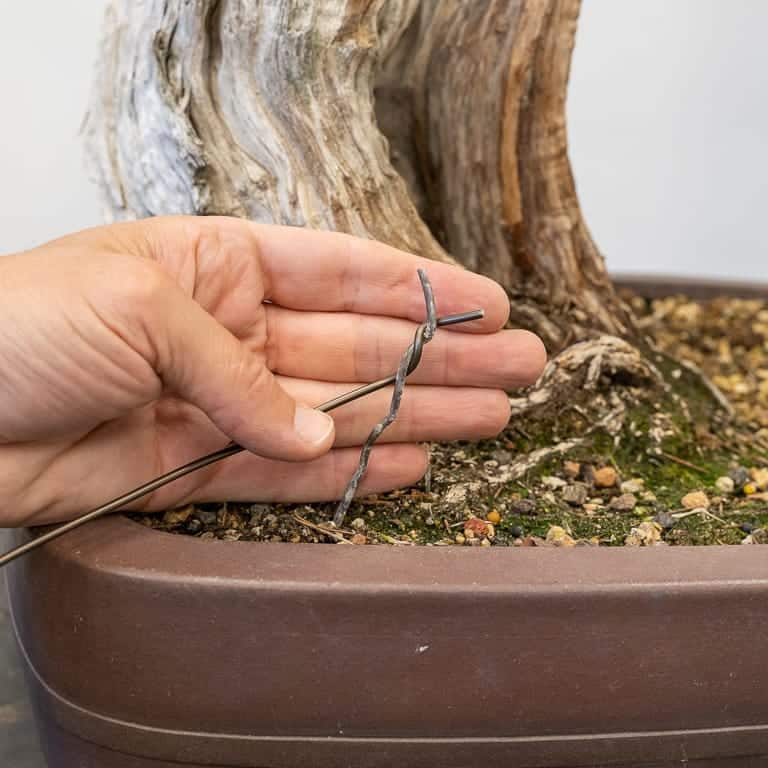
Attaching a new piece of wire on the left side
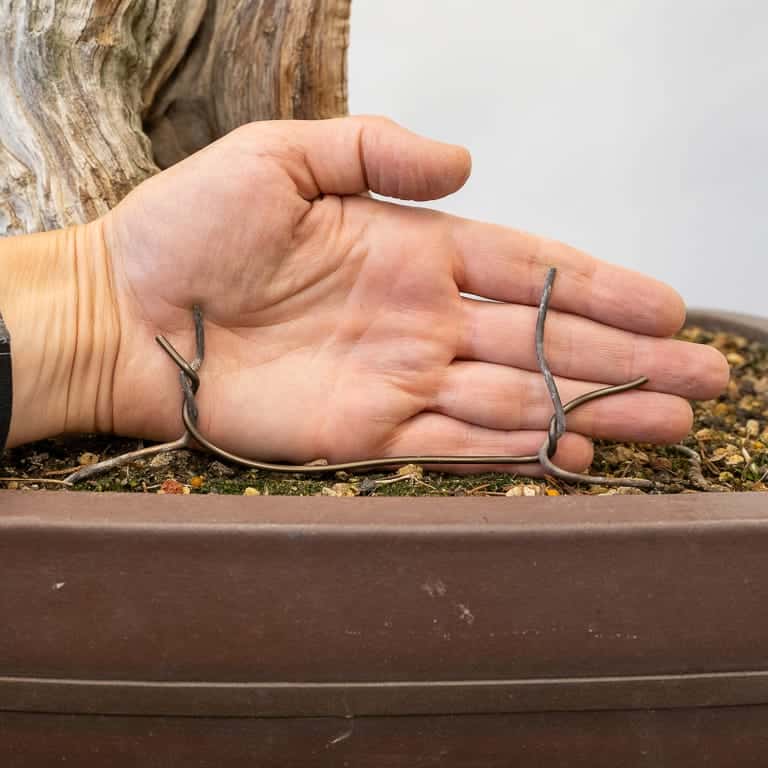
Both sides of the new wire are connected
Adding the new wire allows me to tighten the existing wires by twisting the new connection points. Unfortunately, as the wires began to tighten, one of them broke!
This led me to a second approach for securing trees without repotting: removing the old wires and inserting new wires from below.
Because the soil in the pot had yet to break down, it was easy to slip new wires in the drainage holes from below and attach them as I do when I repot (see “How to secure bonsai in the pot” for details).
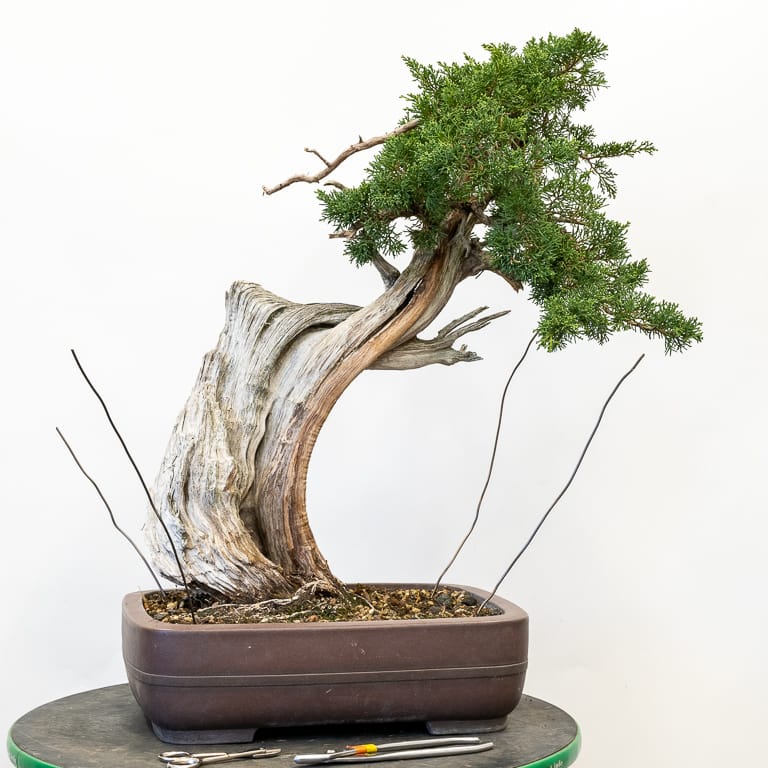
New wires for securing the tree in the pot
Now that the tree was stable, I could remove the wires and think about re-wiring. This is when I noticed that although some of the foliage showed signs of new growth, most of it was green and not growing very much.
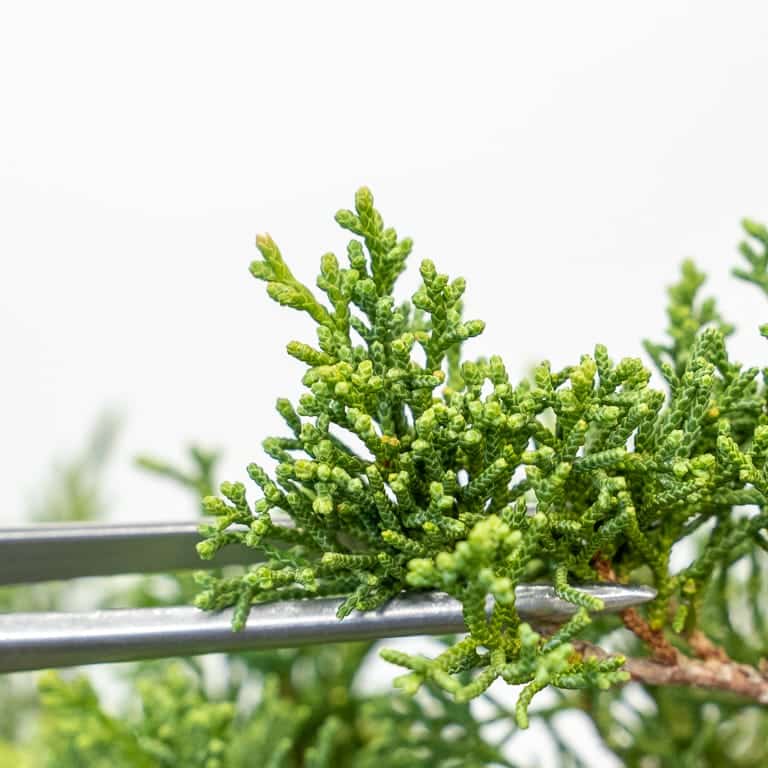
Pale green tips on a healthy branch
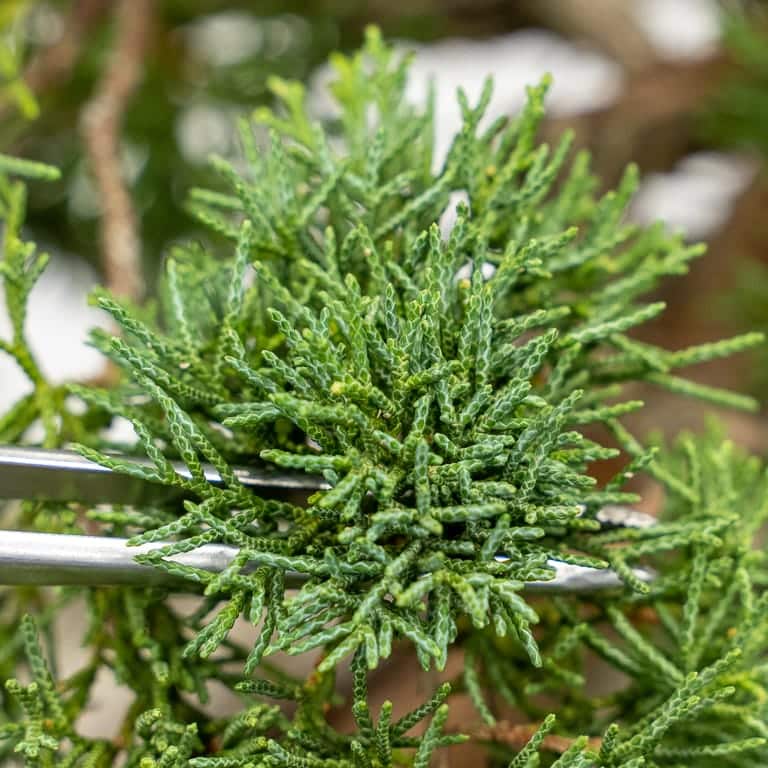
Foliage with good color but few signs of new growth
Knowing that junipers respond to styling much better when they’re strong, I decided to thin the old needles and let the tree grow for a season or two.
Waiting will also give me time to think about the best front and planting angle for the tree. The side we’ve been looking at is a good option for the front, but the other side has similar merits.
Do you have a favorite?
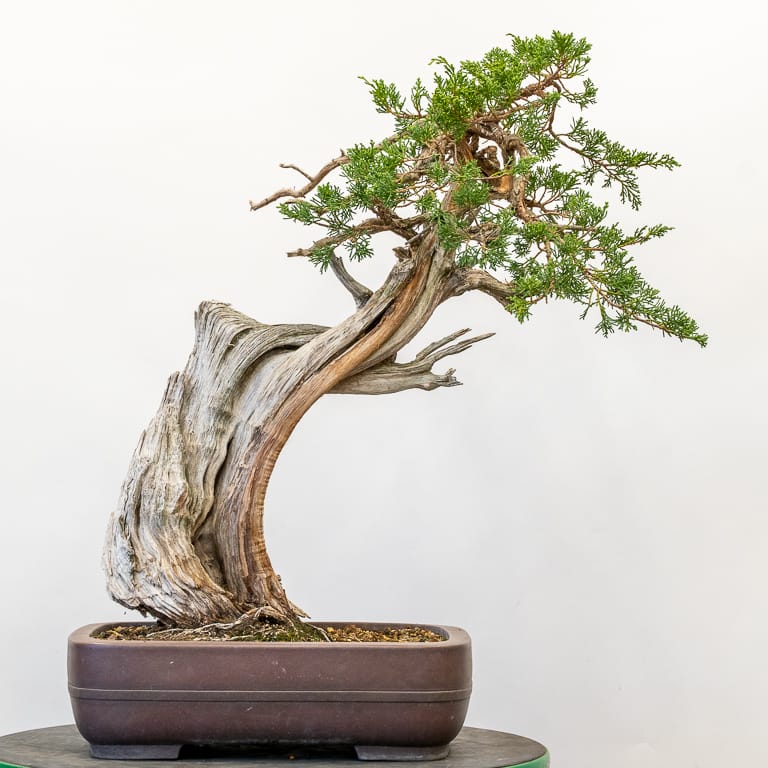
Side A
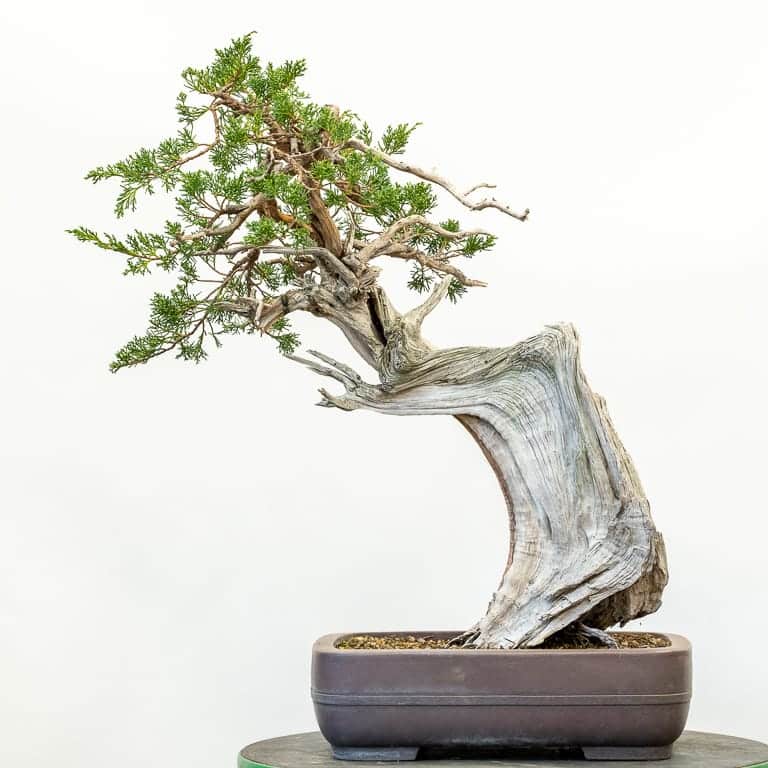
Side B
Soil Update
I’m expecting a shipment of akadama and Aoki Blend pre-mix toward the end of December. In the meantime, I have pumice, kanuma, medium-size akadama, and medium-size Clay King in stock.
I’ll make an announcement when the next shipment arrives. In the meantime, call or email me with questions about bulk orders or the soil available on the online store.
Subscribe to Bonsai Tonight
New Posts Delivered Every Tuesday and Friday
Greg Younger says
I say side A. Beautiful tree!
David R says
Thanks Jonas! Awesome content!
Love the tree. I prefer Side A.
I have recognized that I have a general preference for left to right movement so Side A appeals to me. (Always looking for a tree that I can break that pattern with.)
Because of the undercut on the front right of Side B it looks less steady at the soil line. (This feels ungrounded and works against the rest of the tree for me)
I prefer the more organic flow of the deadwood on Side A as opposed to the angular, almost arm bone like deadwood on Side B.
I like the general appearance of the deadwood going behind the trunk on Side A as opposed to in front on Side B. Side B hides the lower half of the trunk.
But if I were looking to evoke a little worry and push the tree growing out of a skeletal arm image it is a great Halloween tree. OK… Maybe I’m the only one that sees that image in the tree. Doing too many abstract watercolors lately 🙂
Thomas Tynan says
Jonas…..Interesting post today…..the taller the tree the longer the “lever arm” so the force applied at the top of the tree is transferred to the base of the tree and that transfers to the roots; that’s different with a tree that is half as tall. Do you have concerns in this application that the insertion of the wires and the new tightening force applied will crush or cut some of the root mass? How do you prevent that from happening ….get the wires as tight as possible but not damage the roots?
Regards Tom
Jonas Dupuich says
Hi Tom – great question. I’d worry about the roots if the tree were really loose in the pot. In that case, I’d use a wood post to support the deadwood and extend the wires above the deadwood so the post can support the weight.
In this case, the tree wiggled a bit, but the root mass was solid enough to prevent much movement. There was also a small screw into the deadwood that I was able to use to keep the trunk stable relative to the pot.
Peter Grisdale says
Side A all day long, the base looks better (less reverse taper) and the deadwood looks more interesting as side B looks flat, side A has more shape with hollows etc
Awesome looking tree 👍🏻
Mark says
Do I have a favourite? Nope. Firewood doesn’t interest me.
M.
Doug Zeeff says
Jonas, I have two pots that only have one big drain hole and no wire holes. After a failed attempt to wire my trees down in these pots I decided to try gluing them down with a hot glue gun. After one and a half years in the pots both trees are doing great.when it is time to repot I will use a razor blade to cut the glue away.
Jonas Dupuich says
Hi Doug – have you tried drilling drainage holes in your pots? Ceramic bits work great with most pots.
Dawn says
I’m also for “A”. The deadwood ( firewood? Really ? ) is more interesting from that view, and I see more live vein. Beautiful sweeping movement.
Diane Matzen says
Well I have seen this tree before! Love the work you did on it. I prefer the “A” tree’s movement and the clear view of the life line. In “B” I also see a skeleton arm, and the crown is gown very nice on this side as well. Firewood, Mark, REALLY? Thanks all for interesting “takes” on the tree. Wish is were mine!
Charles Mosse says
Side A is the better of the two. Beautiful.
Have had discussions about securing trees without removing from the pot. Some say to just use the bit to drill through the root ball and some say to used chopstcik ro center punch/ice pick to find a good spot. I have successfully drilled holes into pots through the root ball. Used a chop stick to find good spots and then used it to help create a hole for the bit. Then used a 1/8″ x about 6″ ceramic/masonry bit by Bosch. I have done this on more mature root balls that are 1-2 years from re-pot and also like the root ball you described above. No issues in either case.
Did you use a chop stick or other tool to find a good spot and help create a hole to reduce root damage before drilling? If not, is it not necessary for a recently re-potted tree but perhaps a good idea for a more dense root ball?
Jonas Dupuich says
The soil was quite loose so the wire slid right through with no resistance. The one thing I don’t like about drilling through the rootball is that it’s possible to drill through larger roots. This isn’t necessarily a problem but I’d prefer to avoid whenever possible.
Were the soil here more dense, I’d use an awl or screwdriver to poke a path up to the surface. If this didn’t work, I might affix a wire along the outside of the pot or simply repot carefully in spring.
Iris says
IMHO, I would have to agree that side A has the most visual interest. I like the live vein clinging the dead wood and this latter does not overpower the scene like in side B.
Zack Clayton says
Side A. better movement of deadwood, the live vein enhances this movement. There is more textural interest as the presentation is not a flat surface with etched grain as on side B and the tree doesn’t look like it wants to fall over as the live vein on side A presents an anchor to the soil. .